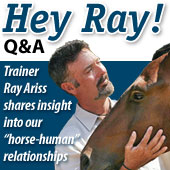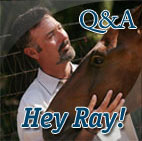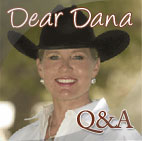Focus, trust end bridling issue
 HEY RAY: I never had problems bridling my horse, then one day I was in a hurry and rushed taking off the bridle. I ended up with the bridle in my hand while my horse was rearing up with the bit clanking on his teeth. Now it’s almost impossible to get the bit in or out of his mouth without him getting tense. What should I do?
HEY RAY: I never had problems bridling my horse, then one day I was in a hurry and rushed taking off the bridle. I ended up with the bridle in my hand while my horse was rearing up with the bit clanking on his teeth. Now it’s almost impossible to get the bit in or out of his mouth without him getting tense. What should I do?
Lance Gunn, Norco CA
HEY LANCE: What happened to you has happened to virtually every horse owner at least once, including me. When I was 10, I had a horse that lacked a good foundation. I had no experience, height or length of arm. I remember trying to stretch up while on my toes, hoping to keep the bit in his mouth while trying to hook an ear into the bridle. I’m sure you know what I’m talking about. This challenge is not just trying to get the bit in his mouth; it has more to do with focus, trust, timing, feel and basic fundamentals about giving to pressure while being scared.
How can I get my horse to stop biting me every time I saddle him?
 HEY RAY: Whenever I saddle my horse, he tries to bite me and moves around every time I cinch him up. The only way I can saddle him is to have somebody strong hold him. What can I do?
HEY RAY: Whenever I saddle my horse, he tries to bite me and moves around every time I cinch him up. The only way I can saddle him is to have somebody strong hold him. What can I do?
Romona Johnson, Orange CA
HEY ROMONA: If that is all he is doing, the solution to your problem may be fairly simple if you try this approach. First, begin by tying your horse in a way that if he pulls, the rope will feed with a decent drag so that the horse has to work at pulling away. There’s a few ways you can do this. You can simply throw a long rope attached to his halter over a rail and back to you so that you can control how you feed the line to him. The rail I am talking about is the top rail of an arena wall or pen, the higher the fence the better. You can also throw the end of the rope over the top rail and wrap it around the post directly below it until you achieve the desired drag or resistance. The end should be left on the ground on the opposite side of the fence. There’s also a tie-ring that you could buy at your local tack store that will do the job nicely. This should take care of replacing your helper and regaining focus from your horse back on you.
How do I get traction with tire obstacles?
 HEY RAY: I took my horse to a local trail competition, and the obstacles were harder than I expected. One that seemed very dangerous was walking over tires. Not only did I almost kill myself, my horse now seems scared of all obstacles. Can you help me?
HEY RAY: I took my horse to a local trail competition, and the obstacles were harder than I expected. One that seemed very dangerous was walking over tires. Not only did I almost kill myself, my horse now seems scared of all obstacles. Can you help me?
Natasja Hanes
Corona, CA
HEY NATASJA: I appreciate your question more than you can imagine. I, too, not long ago experienced a similar situation. I saw the tire obstacle separate the well-trained, broke, sensible horses from the rest of the pack. If I were looking for a horse to buy that day for one of my kids, it would have been the horse that got the high score in the tire obstacle.
Let’s put a halt to confusion about the ‘half-halt’ right now
 HEY RAY!: I’ve ridden over 20 years under several trainers, and they all have used a term that I am embarrassed to admit that I don’t know – a “half-halt”. What is this, and how do we apply it?
HEY RAY!: I’ve ridden over 20 years under several trainers, and they all have used a term that I am embarrassed to admit that I don’t know – a “half-halt”. What is this, and how do we apply it?
Anonymous rider, San Diego, CA
DEAR A.R.: Your situation is a lot more common than you think. You would be surprised how many riders have confided in me that exact same question over the years. This is a topic that I actually like to explain and talk about. Once you have the right visual, it’s a very helpful and effective tool in helping with balance and self carriage.
The lesson isn’t over until ‘eye’ says so!
 HEY RAY!: I always hear about how important it is to put your horse away on a good note. I understand why my horse didn’t improve (or got worse) when I put him away after a bad session. But, why didn’t my horse improve after I put him away on a good note?
HEY RAY!: I always hear about how important it is to put your horse away on a good note. I understand why my horse didn’t improve (or got worse) when I put him away after a bad session. But, why didn’t my horse improve after I put him away on a good note?
Lance Gunn
Norco, CA
HEY LANCE!: Your question is probably the single most important thing you should understand when trying to progress your horse. There are a lot of things you can do in order to train your horse, but nothing is more important than a clear picture.
How do I teach without a fight?
 HEY RAY!: I own a big Warmblood that’s sometimes like a ton of bricks when I turn him under saddle. His nose will point where he should go, but his body does everything but follow. Then he gives me attitude if I try to use my leg or spur to straighten him out. What can I do to fix this without picking a fight I might lose?
HEY RAY!: I own a big Warmblood that’s sometimes like a ton of bricks when I turn him under saddle. His nose will point where he should go, but his body does everything but follow. Then he gives me attitude if I try to use my leg or spur to straighten him out. What can I do to fix this without picking a fight I might lose?
— Tony DeCamillas, Windermere, FL.
HEY TONY!: Your question is very telling. It appears we’ve got a horse that may have some understanding and/or training about what is expected of him. You seem clear about what you would like him to do. You also seem confident enough to use spurs to persuade your horse to do the right thing. My concern is that you may bite off more than you can chew – unless you are absolutely clear on how to counter every move your horse will throw at you in this chess game.
When can I train my dressage mare in foal?
 HEY RAY!: My wife just purchased a third-level dressage mare in foal that is due this spring, and we want to show her in the fall. When can we start training the mare and when should we wean the foal?
HEY RAY!: My wife just purchased a third-level dressage mare in foal that is due this spring, and we want to show her in the fall. When can we start training the mare and when should we wean the foal?
— Brenden Johnson, Eureka Springs, Ark.
HEY BRENDEN: Congratulations on your new addition! The first question that comes to mind is whether or not your mare has been ridden through the pregnancy. If she hasn’t, I suggest you do nothing until after the baby is born. If she has been ridden and your goal is to show her this year, continue to ride carefully and considerately right up until she gets ready to foal, providing she feels up to it.
Is my colt aggressive or too friendly?
HEY RAY!: I am hand-raising two colts, and I am afraid one will be too aggressive – he is already too friendly. What do I look for and do?
Kaitlyn Lebo, Valley Center, CA
HEY KAITLYN: Clearly, you are in touch with your instincts. Your feelings about your colt are probably right, and I bet you are on the right track in addressing these issues now. The way we will assure that you will have a strong and happy relationship with both of your colts will be to have an ideal picture of how you will want them to be – and then work backward from there.
When can you start to drive?
The answer will depend on your horse
HEY RAY: When do you start an Arabian driving or riding?
Teresa Holden
Marysville, CA
HEY TERESA: Your question is very interesting to me because there can be so many answers depending on what your goal or motivation is in getting him started.
When horses rub the wrong way, it’s time for some communication
HEY RAY: My horse stops and rubs his face on his foreleg while I’m riding. I’ve checked the bit, bridle and have had several vets say his teeth are fine. What do I do?
Leo Ortman
Cupertino, CA
HEY LEO: I have to agree with your vet; I don’t think it’s his teeth, bit or bridle. As a matter of fact, I have two horses in my barn that have the same behavior, one of which is my wife’s Friesian stallion.



 Read Columns
Read Columns

